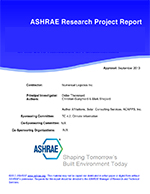Description
Building energy analysis programs are, by the nature of the processes they seek to model, complex and require detailed input data involving many parameters. Demonstrating the validity of results, and diagnosing deficiencies in the calculation method or its computer implementation can be correspondingly difficult. The need for some form of validation of building energy analysis codes has been long recognized. A number of attempts have been made over the last two decades to identify suitable validation procedures by a number of organizations (e.g. NREL 1 , NIST 2 , BRE 3 , BEPAC 4 , IEA 5 ) but no standard procedures have been universally accepted despite the proliferation and increased use of such programs. Three types of validation methods can be identified (Judkoff, 1988, Bloomfield 1999) in which results from one code are compared with results from other sources. The sources of comparison data can come from: · analytical models, · inter-model comparisons · empirical test results. Of these approaches to validation the use of analytical tests are most abstracted from the full complexities of real building simulation problems but offer the most certain form of reference or ‘truth’ model with which comparisons can be made. Being slightly abstract in nature they may be of least interest to the end user of simulation codes but are arguably the most useful to the code developer in that they offer the clearest path to diagnosis of specific problems with the algorithms or their implementation. It is the objective of this project to develop a suite of analytical tests to be used in testing the building fabric aspects of building energy analysis programs. Analytical solutions, in order to be tractable, have to be limited in scope and make a number of simplifying assumptions. Their purpose is to help in verification of the proper functioning of certain models and sub-models, rather than validation of the whole test program’s ability to model real situations. We make the distinction between code verification and validation following the definitions given by Boehm (1981) and Blotter (1990). They described verification as “solving the equations right” and validation as “solving the right equations”. Furthermore, we use the term analytical to mean a mathematical model of reality that has an analytically determinable solution for a given set of parameters and boundary conditions.
Principal Investigator: Jeffrey D. Spitler, Oklahoma State University
Conducted: April 2001
Sponsored by: Oklahoma State University
Product Details
- Published:
- 2001
- File Size:
- 1 file , 2.3 MB
- Product Code(s):
- D-8228




